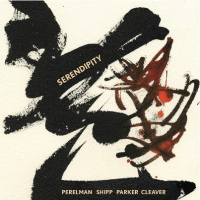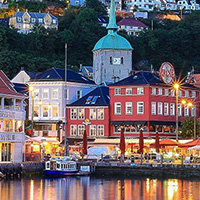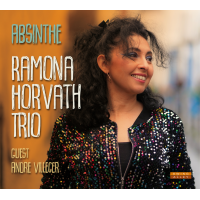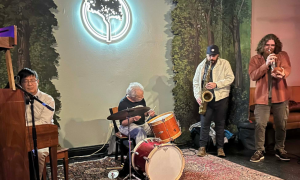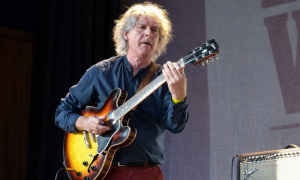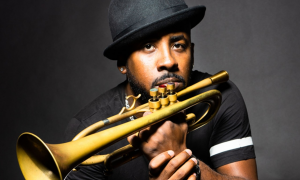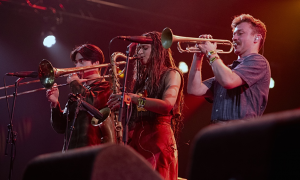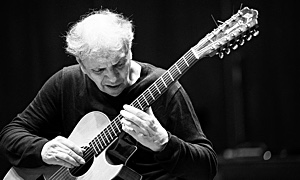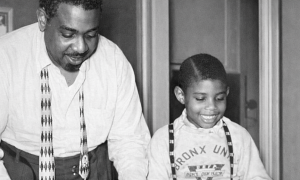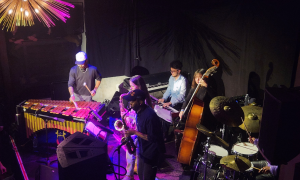Home » Jazz Articles » Live Review » Molde International Jazz Festival 2013
Molde International Jazz Festival 2013
In his second performance of the week, Herskedal, too, impressed, in particular during his own composition, where an a cappella intro combined electronics and extended techniques to create something distinctly un-tuba-like, while Sharkey's southpaw creation of shimmering arpeggios and harder-edged lines early in the set were still a surprise to those familiar with his work in trioVD and, more recently, The Geordie Approach. Zanussi and Baggiani kept the engine stoked while, at the same time, responding to their musical partners and, as was most clearly seen in the after-show, friends as well. It was clear that the group had applied many of the lessons learned at Take Five Europe, most notably in its maintaining of the pace of the set and delivering introductions (because it was in Norway, from Zanussi and Herskedal) that were concise and to the point.
July 19: Jason Moran & Jan Bang / Obara International
With the majority of Molde Jazz Expo delegates gone, if the weather didn't exactly improve significantly, there was at least some improvement—brief periods of sun, even, that allowed the natural beauty of the surrounding area to emerge more clearly, though wind and rain were rarely far behind.
This was all the more reason to stay indoors and catch one of the most anticipated of Jason Moran's residency performances, and a new group teaming two Poles with two Norwegians for a group already generating considerable buzz.
First, in the Teatret Vårt Konsert, Moran's duo show with Jan Bang was everything fans of the Norwegian live sampler had hoped it would be—and more. A pairing that literally happened over a beer when the two met at a European festival some time ago, it took this residency to create a context where the two could come together and, with little preparation, see just what might happen. If any show was to illustrate the absurdity—and lack of necessity—of drawing boundary lines based around country, culture and genre, it was this one. Through Bang's Punkt festival, he has experienced increasing opportunities to collaborate with musicians from other countries and, if there's any single thing that defines Bang and has garnered his reputation, it's that his eyes, ears and mind are never anything less than completely open to the possibilities around him. Combine that with a similar quality in Moran and it was the recipe for a performance that spent time exploring both sides of the Atlantic, but more often than not, found a happy nexus point smack dab in-between.
With Moran playing Fender Rhodes in addition to grand piano, it gave the pianist an opportunity to expand his textural contributions; still, during the opening piece he focused on grand piano and, when Bang began to sample and process his music, it took on some of the complexion of Harold Budd's '80s collaborations with Brian Eno, except that Moran and Bang were creating this music in real time, and without the benefit that time (and the opportunity to correct) provides in the more controlled environment of the recording studio; this was musical risk-taking made all the more impressive by the clear fun being had by both players. Moran did move over to Rhodes at one point, but as Bang and Moran periodically smiled at each other (as if something had passed between the two of them), he returned, once again, to acoustic piano to finish a hypnotic piece that ultimately lasted nearly 35 minutes.
The second piece began, with Moran once again on acoustic piano, more on the American side of the ocean, and it was quite something to see Bang's response to being placed in a context in which he rarely has been placed—the American jazz tradition. But rather than feeling out of place—though he certainly was challenged—the constantly in-motion live sampler simply—and literally—laughed out loud. Bang's a positive force in music, and one who is quick to show the happiness it brings, but rarely has he ever responded so vocally.
As the pair moved into its third piece, Bang opened with an exotic orchestral sample that led to a repetitive motif which, sounding like a supercharged balafon with an underscore of sonic washes, vocal utterances and the occasional deep bass pulse, created a space for Moran's layered Rhodes explorations, which were suddenly left completely on their own when, suddenly and unexpectedly, Bang pulled out entirely. Still, it wasn't long before Bang was once again sampling Moran who had, by this time, moved to a more funk-driven acoustic piano, with Bang simply—and uncannily accurately—turning a dial to alter the sample's pitch to evoke a clear melody.
But that was far from the end, as Bang astutely picked up Moran's long, cascading phrase and, pushing it up an octave (and then more), used it to color Moran's move into a gospel-inflected passage of unadorned beauty.
Both players, throughout the set, found ways to push their own limits and achieve results they might otherwise not have. At one point in the closing piece, Moran stopped playing and, picking up the microphone normally there to simply make introductions, began whistling a theme that Bang had introduced moments earlier, the set drawing to a sudden close with Bang's infectious laughter. The music Moran and Bang made may have been serious at times—dark, even—but the spirit of collaboration and a first encounter made it not only fun for the players, but for the audience as well. With Bang inviting pianist Tigran Hamasyan to this year's ninth edition of the Punkt Festival in early September, it wouldn't come as a complete surprise to find Moran on the list in 2014, when Punkt celebrates its 10th anniversary in Kristiansand.
Arriving late upstairs at Teatret Vårt Natt, it was immediately clear that something special was already going on. Already in the midst of a powerful solo, Polish altoist Maicej Obara was being driven by fellow Pole, pianist Dominik Wania and two Norwegians—bassist Ole Morten Vågan and drummer Gard Nilssen, playing a considerably downsized kit compared to his Bushman's Revenge show from two nights previous. Clearly in deep concentration, Nilssen's light touch was an almost polar opposite to his thundering grooves with Bushman's, but that needn't suggest a lack of power...only a different kind of energy.
Three-quarters of the quartet came together at the 2012 edition of Take Five Europe, where Obara, Nilssen and Vågan were participants. But it was when the saxophonist invited his two friends to Poland, where they met Wania, that Obara International came to be, recording Komeda: Absolutely Live! (For Tune, 2013) in Poland during the summer of 2012. A year later, the quartet was performing its own music rather than its debut—a tribute to the famous Polish composer Krzysztof Komeda that combined unfettered power and graceful lyricism. The cover sleeve of that recording has Obara's writing: "I am presenting you here with a recording that is particularly important to me. I hope that you will hear what I hear in it: artists that understand each other without words, whose energy drives, inspires and motivates to act."
All of these things and more were clear in the quartet's set. Vågan and Nilssen are two of the busiest players of their generation in Norway, and for good reason. Vågan's aggressive approach—slapping, plucking, hitting, scraping his bass strings—is the closest thing Norway has to a player coming from Charles Mingus, though in some of the other groups with which he is involved, in particular Mellow Motif and, more recently, The Deciders, he's far more outrageous and free. Here, while there was plenty of freedom, it was based around stronger structural contexts, and Nilssen was the ideal rhythm partner: loose, flowing—at times swinging, but equally strong at rubato playing. Wania's major touchstone could easily be McCoy Tyner though, with his approach infused with classical ideations, it was, perhaps, more Richie Beirach than John Coltrane's quartet mate. Obara was nothing short of a revelation; an altoiost unafraid to try anything, but constantly listening to the music around him in order to find that shared understanding.
It's no surprise that, after seeing the group a week ago in Munich, there's some interest from ECM Records' Manfred Eicher. Whether or not anything will come of it is yet to be determined, but if Obara International's next record comes out on the lauded, internationally renowned label, it will only mean good things for the group—and for fans of music around the world who value the kind of music that comes from four musicians communicating on such a profoundly deep level.
July 20: Maria Kannegaard Ensemble / Hedvig Mollestad Trio
One of the most noticeable differences between the last visit to Molde in 2010 and the current year was the density of programming. In 2010, it seemed as though there was so much from which to choose, and so much running concurrently, that shows had to be only partly seen, or skipped entirely. 2013's lighter schedule meant the ability to see more, but still—as with any festival taking place over as short a period as six days—there's always the risk of overload, making it better to stick to two or three shows per day.
The festival's final day had another eagerly anticipated show of the 2013 edition—pianist Maria Kannegaard's new ensemble—and a chance to close out the festival, before another characteristically outrageous early morning pickup, with guitarist Hedvig Mollestad, whose second release on Rune Grammofon, 2013's All of Them Witches, was another surprising (in the best possible way) release from a label that's become one of the country's best-known and most respected on an international basis. That both Kannegaard and Mollestad are women only means that there's proof positive that the imbalance between genders in the world of jazz is slowly correcting itself, and that it should have no bearing on how a group or artist is described or assessed.
Kannegaard has been around longer, with groups like Maryland and the trio that, featuring bassist Ole Morten Vågan and drummer Thomas Strønen, formed the core of her new sextet, which also included (in yet another Molde appearance) violinist Ola Kvernberg, keyboardist Ståle Storløkken (another multi-show performer) and, making his first appearance at the 2013 edition, trumpeter/vocalist/percussionist Per Jorgensen—whose inimitable approach, not just to his instruments, but to music, has rendered him not only an invaluable member of Jon Balke's Magnetic North Orchestra and Jøkleba!, but to any constellation in which he's a part.
Kannegaard's trio music—last heard on 2008's Camel Walk (Jazzland)—was (and is) a more idiosyncratic affair; the music performed by this ensemble, while reflecting some of the repetitive elements that make up Kannegaard's trio music—as well as including some percussive elements and knottier constructs—nevertheless represents some of the most purely melodic music of the Swedish-born/Norwegian-resident pianist's career.
Some music is meant to be heard; other music is meant to be felt. Some music requires a conscious brain; other music is more transportive in nature, music that transcends conscious thought and goes on a journey that, if successful, takes its audience along for the ride. Dissecting Kannegaard's music would almost take away from its successful sojourn, one driven by both the music the pianist has written and the way that it was performed by a group clearly selected for its individual skills.
Much has already been written about Kvernberg's two other Molde performances; suffice to say that here, in a thoroughly different context, his ability to mold himself to the demands of the music remained intact, turning from the high energy of Bushman's Revenge and the more abstruse nature of the Albatrosh/Trondheim Jazz Orchestra to a more decidedly lyrical bent, but one that also took advantage of the violinist's textural strengths as well. Vågan's role was less aggressive here, and if his work with Obara International was the epitome of power and drive, here it was not so different, only executed with greater elegance and gentility. Storløkken's role here was more textural as well, with no Hammond to be found, only racks of synthesizers that he used to both create sonic soundscapes and mirror Kannegaard's own parts, which leveraged both thematic constructs and repetition that seemed informed by minimalism, but more indirectly so.,
Making their first 2013 Molde appearances along with Kannegaard, Strønen and Jørgensen are two players more fully defining the pianist's music. Strønen's flowing ability with a kit was matched, at least during one segment in the set, with his remarkable adeptness with electronics, his hands and fingers moving so rapidly amidst his pads and buttons as to be nearly invisible, as he morphed sounds on the fly—planned and unplanned, preconceived and in the moment. Jørgensen, always a charismatic performer even as he does everything from a seated position, provided a melodic fulcrum, his open trumpet a thing of beauty, his muted horn vulnerability made sound. When he sang, it added soft humanity at times, but when he resorted to his near primal screams in a language still to be determined, it imbued the music with plaintive cries of both beauty and pain.
It's been some time since Kannegaard has released a recording, and while she has three recordings lined up for a box next year, that does not include the music she performed at Molde. That, she revealed in discussion after the show, will be recorded sometime in 2014, for release later that year or, perhaps, in 2015. It'll be a long wait for that record, but one that will undoubtedly be worth it.
And so, before hitting the sack for a brief three or so hours of sleep prior to heading to the airport and the next destination, it was impossible to say goodbye to Molde without at least checking out half an hour or so of Hedvig Mollestad's trio, coming on after a late-starting set by singer Beady Belle. Contrasting Belle's largely chill-out set, guitarist Mollestad (actually Hedvig Mollestad Thomassen) bassist Ellen Brekken and drummer Ivar Loe Bjørnstad delivered at least an opening portion of their set, culled from All of Them Witches, with even more amped up power. This was instrumental rock music, but played by a guitarist who has clearly developed a richer language through her jazz studies. With two large hollow body electric guitars, Mollestad went against the grain of the usual solid body guitarist, but still relied heavily on her whammy bar to make her chords sing and pulse. Brekken, while playing electric bass, seemed more disposed to her double bass, certainly a rarity in music of this energy and volume. Bjørnstad had all the power he needed to drive the trio, but in the one gentler tune played before leaving the show he also demonstrated a penchant for lighter cymbal work and softer tones, suggesting something broader at work. It was an energetic, electrified performance whose only downfall was its start time, making it impossible to stay until the end.
It was a shame to have to leave the show, but a necessity. As the plane took off in the early hours of Sunday, June 21, with three flights, a bus and a train on the horizon to get to Siena, Italy, the overriding feeling was that, with Molde Jazz Festival about to change hands, its future may be uncertain—not, in the hands of Anders Eriksson, that it will be anything but promising, but it most certainly will be different—but as Jan Ole Otnæs prepares for his own relocation to Oslo, population half a million, after living in a town of 24,000 for the past 13 years, he has left a clear legacy that will not soon be forgotten. Thankfully, his work will continue, albeit in a much different context; so as Molde continues under new leadership, it will certainly be Nasjonal Jazzscene Victoria's gain.
Photo Credit: John Kelman
Tags
Live Reviews
John Kelman
Norway
Bergen
Molde International Jazz Festival
Arve Henriksen
Nils Petter Molvær
Dave Holland
jason moran
charles lloyd
Taurus Mateen
Nasheet Waits
Thelonious Monk
Jan Bang
Paal Nilssen-Love
Stian Westerhus
Bill Frisell
Terje Rypdal
Albatrosh
Trondheim Jazz Orchestra
Bushman's Revenge
Ola Kvernberg
Maria Kannegaard
Greg Osby
Stefon Harris
Paul Motian
Daniel Herskedal
marius neset
Spunk
Jaga Jazzist
Mats Eilertsen
Karl Seglem
Tim Berne
Jenny Scheinman
Eyvind Kang
Hank Roberts
Fats Waller
Craig Taborn
Supersilent
Humcrush
Elephant9
Paolo Vinaccia
Arild Andersen
Jon Christensen
Jan Garbarek
Bobo Stenson
Hendrix
daniel smith
Ornette Coleman
Jerry Goodman
King Crimson
Mahavishnu Orchestra
john mclaughlin
Rick Laird
Per Zanussi
Arun Ghosh
Chris Sharkey
john zorn
trioVD
Brian Eno
Tigran Hamasyan
Krzysztof Komeda
Charles Mingus
Motif
McCoy Tyner
Richie Beirach
John Coltrane
Manfred Eicher
Thomas Strønen
Per Jørgensen
Jon Balke
PREVIOUS / NEXT
Support All About Jazz
 All About Jazz has been a pillar of jazz since 1995, championing it as an art form and, more importantly, supporting the musicians who make it. Our enduring commitment has made "AAJ" one of the most culturally important websites of its kind, read by hundreds of thousands of fans, musicians and industry figures every month.
All About Jazz has been a pillar of jazz since 1995, championing it as an art form and, more importantly, supporting the musicians who make it. Our enduring commitment has made "AAJ" one of the most culturally important websites of its kind, read by hundreds of thousands of fans, musicians and industry figures every month.


